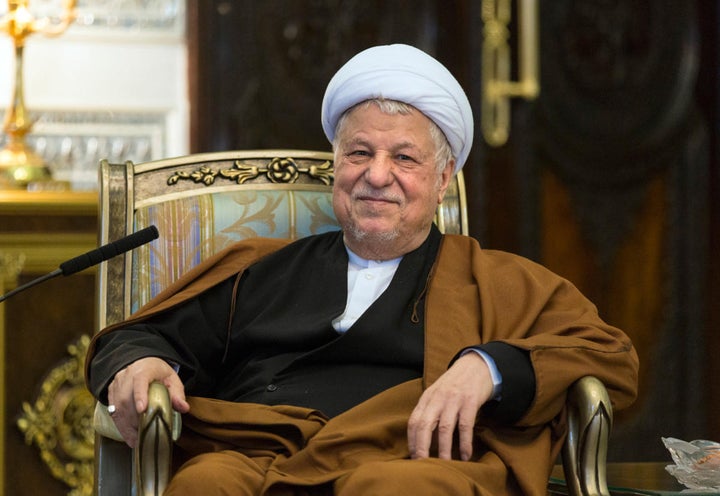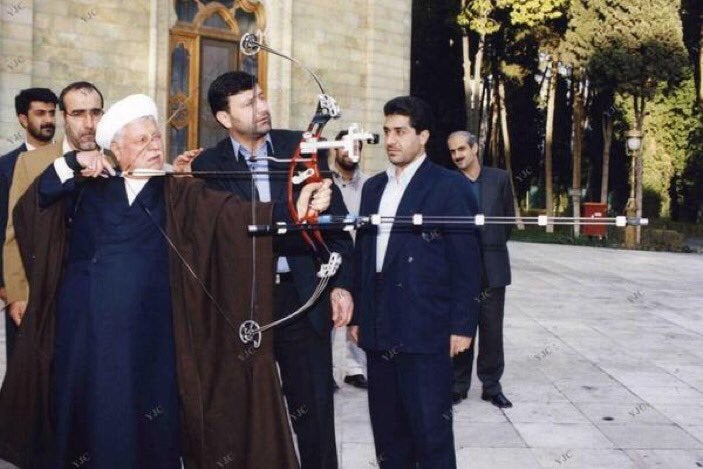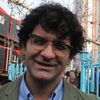
Iranians will go to the polls next Friday, May 19, to vote in their country’s 12th presidential election, their first without Ali Akbar Bahramani. Better known as Hashemi Rafsanjani, there is a sense inside of Iran he was the one who held it all together, the pivot of the Islamic Republic’s odd universe, its indispensable man.
Rafsanjani, who died suddenly earlier this year at the age of eighty-two, was no less indispensable to his enemies, who saw him as the incarnation of all the flaws and failings of the revolution, its corruption and criminality. That at the end of his life it was difficult to tell who was friend or foe ― many had been both, sometimes at once ― spoke to Rafsanjani’s singular and outsized presence in the firmament of Iranian politics, a man whose greatest legacy may have been to play accidental midwife to Iran’s nascent civil society.
In the past 40 years, no other major figure more embodied the fraught relationship Iranians have had with their government and system, the call-and-response collaboration between politician and citizen that came into its own during the 2009 Green Movement. Recognized by ordinary Iranians as a credible and above all, effective force for change, Rafsanjani served, in the final years of his life, as a vessel for the public’s will, as well as a catalyst for its transformation. In giving voice to their protests on the streets and at the ballot box, Rafsanjani helped millions of Iranians find their own.
In truth, the effect was mutual. Rafsanjani grew into his position, changed as much by his encounter with the public, as the public was by him, proof that politics can serve the greater good even when it is made by less than noble politicians. Like all such stories, Rafsanjani’s tale of redemption began after the fall.
Rejected by the Great and the Ordinary Alike
By the time he was elected to the presidency in 1989, with more than 96 percent of the vote, Rafsanjani had already served for nearly a decade as speaker of the parliament and member of the Assembly of Experts. He leveraged the latter position to successfully maneuver Ali Khamanei into the position of Supreme Leader, following the death of the Islamic Republic’s founder, Ayatollah Ruhollah Khomeini. Rafsanjani was at the height of his power and popularity. It would all be gone in just a few short years.
Rejected outright by an ascendant reform movement whose leaders he had conspired to exclude from the political arena, Rafsanjani came to be reviled by erstwhile allies in the conservative camp, who saw in his free-market reforms and willingness to engage with governments in Europe and North America a betrayal of the revolution and Iran.
Rafsanjani fared even worse with a voting public, which blamed him for sharp increases in unemployment and inflation in the aftermath of the war with Iraq, even as his own family prospered. Dogged by allegations of cronyism and even murder, by 2000 it was all that Rafsanjani could do to win a seat in parliament (in the end, he did not serve). The final, lethal humiliation came in 2005 when an ill-fated bid for a third term as president ended in a devastating second round defeat by an obscure former regional governor, the newcomer Mahmoud Ahmadinejad.
Rafsanjani’s Last Friday Prayers
His rebirth came in the summer of 2009, baptized by the wave of protests produced by Ahmadinejad’s reelection that June, an implausible victory that led to days, then weeks of protests that represented the worst civil unrest in Iran since the overthrow of the Shah in 1979. Demonstrations soon spread across the country as millions, under the banner of the Green Movement, demanded their government answer the question: “Where is my vote?”
Protests spilled over into July. With the public in open defiance and the fundamentals of the system increasingly under threat, it was announced that Rafsanjani would lead the weekly Friday prayers at the University of Tehran, the regime’s centerpiece political event. It was an audacious, if risky, move by an increasingly anxious leadership to end the growing chaos.
Once again, the old revolutionary stood between the public and an ascendant Ahmadinejad. Unlike in 2005, this time he would not stand alone.
In the afternoon of July 17, 2009, on what was an exceptionally hot day, Rafsanjani took to the tribune in what would be his last major public address. There to report on the event, what I remember most were the crowds. They had gathered outside the campus grounds, already several lines deep by the time of my arrival, their chants by turns taunting, pleading, and vigilant, but always full of expectation:
“Hashemi! Hemayat! Hemayat!”
“Hashemi! Help us! Help us!”
“Hashemi agar dar sookoot bashi, shoma ham khaen in!”
“Hashemi, if you remain quiet, then you are a traitor also!”
Rafsanjani began his sermon with all of the standard revolutionary fare, pabulum about why religious values and democracy go hand in hand, that if Iran were just a republic, then corruption would seep into the body politic, while if there was only a focus on religion and Islam, then the country would surely degrade into a desert (“biaboon”) and ruin.
In the second half of the address, Rafsanjani tilted the balance towards the crowd. A man who had seen his own popularity ruined, he deftly applied the Prophet Muhammed’s admonition that rulers must always seek the approval of the public. Without the people, there was nothing, Rafsanjani proclaimed. If the vote was stolen, then the government had nothing. If the people believed the voting was corrupt, even if it were not, the consequence was the same.
Rafsanjani reminded his audience that although the Prophet had designated his son-in-law to be his successor, Imam Ali waited over two decades to assume leadership of the community of believers following Mohammad’s death. Ali had refused to use force against the will of the people, a reference that bloodlessly, ruthlessly, quietly, cast Ahmadinejad in the role of Abu Bakr, Ali’s usurper.
With the prayers over, the relieved crowd poured onto Taleqani street and wheeled north towards Vali Asr Square. The PA system hidden in the trees and telephone poles that ran around the university crackled to life.
“Marq bar Amrika! Marq bar Amrika!”
“Death to America! Death to America!”
The people showed little patience for such foolishness. Marching away they shouted back:
“Marq bar Russi-e! Marq bar Russi-e!”
“Death to Russia! Death to Russia!”
I asked one of the crowd members, “What comes next? Where do we go, how do we get there? What is the institution that will meet Hashemi’s call?”
“What is next?” The man was incredulous. “We are, the mellat is the institution! Aziz e man, noon e gol in ghazie ra hal nemikon e. Hazine dare.” My dear, bread and flowers won’t solve the problem. There is going to be a cost.
The cost for Rafsanjani was immediate. His subtle warning to government hardliners had not gone unnoticed and they redoubled their efforts to keep him away from the public square, effectively preventing him from addressing the masses again. They did so, even though Rafsanjani had included a conciliatory gesture, a call for patience to those still protesting the vote. Imam Ali and his followers had waited twenty years before coming into power, he reminded them. If they had to wait another twenty before justice could prevail, then so be it.
Rebirth: The 2013 Elections
In the end, it would only take four. Barred from running again for the presidency in 2013, Rafsanjani operated behind the scenes throughout the presidential campaign, coordinating with multiple constituencies as well as former rivals, including President Mohammad Khatami, to ensure the opposition would enter the final days of the campaign unified and with the best possible candidate to defeat their conservative rivals.
Their choice was Rafsanjani’s friend and protégé, Hassan Rouhani, who enthusiastically took up the mantle of opposition and reform. In rallies and interviews, Rouhani proved to be as capable as his mentor – the only candidate capable of effectively engaging with the public on a range of issues, from the loss of manufacturing jobs in the textile industry to holding state media accountable for failing to report the full truth to the public. Again the crowds spoke back, as I reported from Shahid Shiroodi stadium in downtown Tehran, the site of Rouhani’s raucous final campaign rally:
“Zendanian e siasi bayad azad gardand!”
“Political prisoners must be released!”
“Long live Hossein! Mir Hossein!”
Rouhani’s decisive and unanticipated victory on June 14, 2013 served notice of the premature nature of reports about the demise of the Green Movement, which had been headed up by presidential candidate Mir Hossein Mousavi. The end of the Ahmadinejad era sent the crowds back into the streets. Their cheers celebrated what had been denied in 2009, which was now partially redeemed:
“Mousavi, ma rai e to ra pas gereftim! Mousavi, ma rai e to ra pas gereftim!”
“We got your vote back! We got your vote back!”
“Ahmadi bye-bye! Ahmadi bye-bye!”
“Ahmadi bye-bye! Ahmadi bye-bye!”
The chants continued throughout that night, jeers that no doubt offered a measure of satisfaction for at least one ex-president listening from campaign headquarters.

Democracy’s Prince
Like the shahs of old, Rafsanjani accumulated a variety of titles and nicknames over the course of his long public life, which were a blend of the affectionate and sarcastic. Within Iran, he was known as “Akbar Shah,” “kooseh” or “shark” (on account of his inability to grow out facial hair as well as his political acumen), or simply, “Hashemi.”
American and European observers, by contrast, preferred the moniker of “the Iranian Machiavelli,” a label applied under the mistaken, if common, assumption that Niccolò Machiavelli’s prince understood politics to be cruelty, constituted by the mercenary pursuit of self-interest.
In fact, the truth was closer to the opposite. It was Machiavelli’s great insight that good politics were often made by bad men. Throughout The Prince, he argued that the preservation of the ordered state was the predicate of the good, and that the principal task of the prince was to secure, by whatever means necessary, the conditions for the general welfare.
The recognition that public virtue was frequently tied to private vice, that power could only be met by power, is why the public returned time and again to Rafsanjani despite his evident flaws.
It is one of the enduring contradictions of Iran’s democratic opposition that it relies on the state for its effectiveness. For some years now, the reform movement has pursued a strategy of fortifying its lines by drawing upon the earthworks that surround and protect the very system that it seeks to change, including regular participation in elections and the appropriation of the revolution’s “Islamic values” for its agenda of expanding the rule of law and personal freedoms within Iran.
In this protracted war of position, an insider was needed, a formidable figure capable of subduing the powerful few in a way that would both satisfy and amaze the many. Against a state and revolution that actively, at times relentlessly, sought the spiritual redemption of its population, most Iranians wanted only to be left alone, to experience the profane pleasure of privacy. For this, they needed neither savior nor saint—Rafsanjani was hardly either—but a politician.
Dispensing with the Indispensable
But did they still need him?
Rafsanjani’s death has led to a fair share of hand wringing and consternation within and outside Iran. His passing from the scene comes at an inauspicious moment, with Iran heading into the final stages of a presidential season just as the Americans were coming out of theirs. As Rouhani faces an emboldened opposition at home and the rise of a more belligerent politics out of Washington, there are legitimate worries the incremental, but significant, gains made in recent years by centrist and moderate forces are now at risk.
On January 10, 2017, hundreds of thousands gathered in and around the grounds of Tehran University, for Rafsanjani’s funeral ceremony, held under the dismal skies of late winter. Iran’s Leader, Ayatollah Ali Khamanei, led the procession and service, eulogizing Rafsanjani from the same dais where eight years earlier he had delivered his final, and most memorable, Friday Prayers service.
“Ya Hossein! Mir Hossein! Ya Hossein! Mir Hossein!” Outside the stadium, the chants evoking the names of the imprisoned rose, up and over the official prayers being offered inside. Is Iran’s democratic movement still in need of an indispensable man, or woman? The crowds gave their answer, their trilling voices evidence that the good would live on without Rafsanjani, that whatever evil had been done during his lifetime would soon be interred with his bones.
This essay originally appeared on May 15, 2017, in Muftah Magazine.
